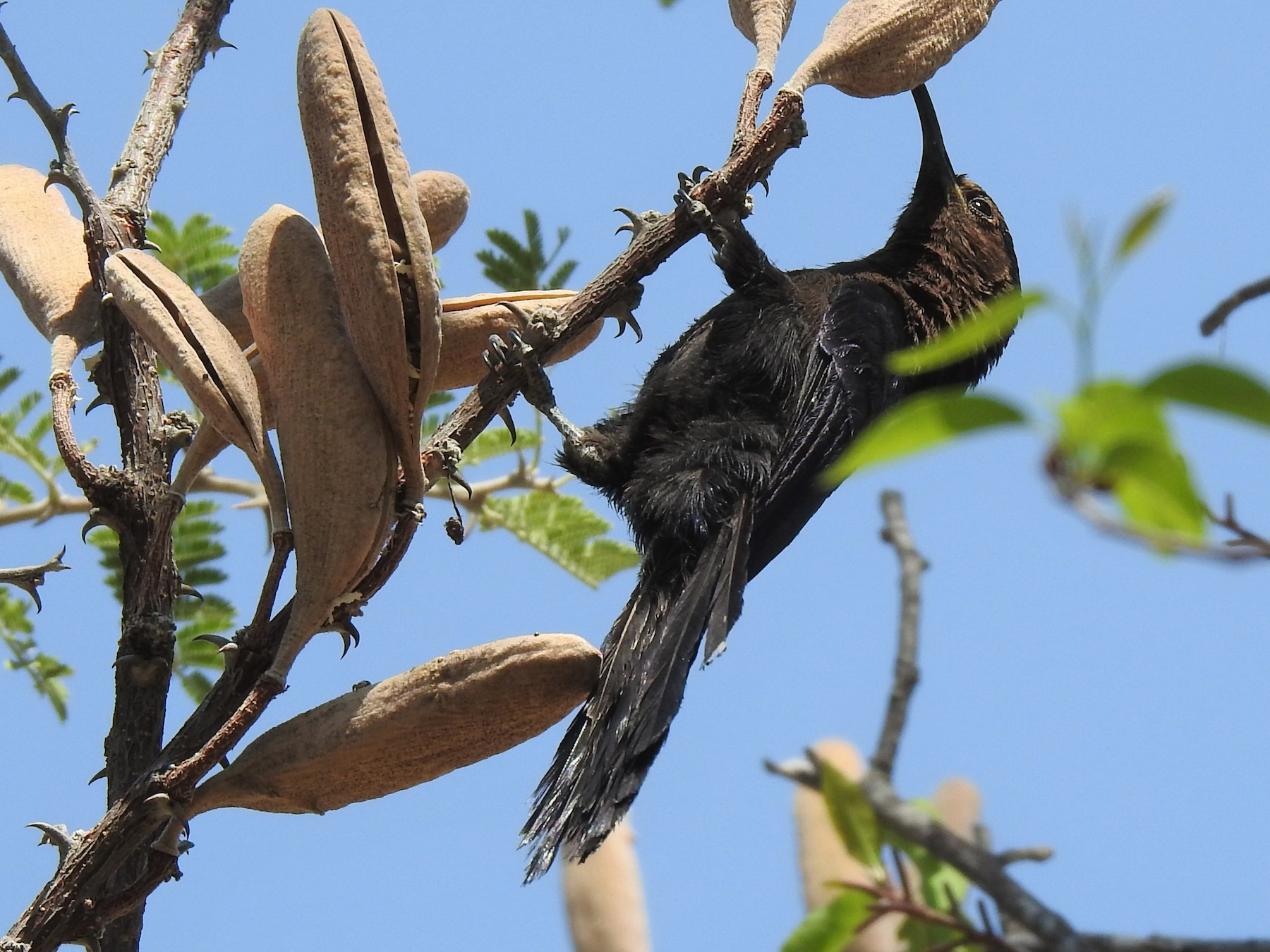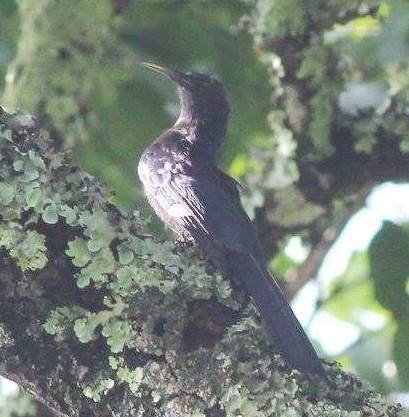Common Scimitarbill Bird Details
Rhinopomastus cyanomelas
Common Scimitarbill,Scimitar-billed Wood Hoopoe, Blue-billed Wood Hoopoe;
Singhdar Bulbul
Vieillot, 1819
Bucerotiformes (HOOPOES and HORNBILLS)
Phoeniculidae
Rhinopomastus
South Africa, Botswana, Namibia, Zimbabwe, Mozambique, Tanzania, Kenya, and parts of Angola, Zambia, and Malawi
Appearance :
Small to medium-sized bird, typically around 20-24 cm in length. Glossy black plumage with a slight iridescent green or blue sheen. Distinctive long, downward-curved bill, resembling a scimitar, which is adapted for probing bark or soil. Short wings, with white spots on the flight feathers. Males and females look similar, though males tend to have slightly longer bills.
Behaviour :
Common Scimitarbills are often seen alone or in pairs, but occasionally in small family groups. They are not as gregarious as other wood hoopoes. Highly vocal, they produce a variety of calls to communicate with others, including harsh, repeated notes. Known for their acrobatic foraging behavior, hopping between branches or clinging to tree trunks.
Habitat :
Prefer dry, open woodlands, savannas, and thornveld areas. Often found in regions with scattered trees and bushes, where they can forage for insects under bark and in the crevices of wood. They can also be seen in gardens and suburban areas.
Diet :
Insectivorous, feeding primarily on insects such as ants, beetles, termites, and spiders. Uses its long bill to probe into cracks and crevices to extract prey.
Conservation Status :
Least Concern
Distribution :
Widely distributed in sub-Saharan Africa, mainly in southern and eastern parts of the continent.
Population Size :
Exact population size is not well-documented but considered stable.
Life Span :
Life span is estimated to be around 5-10 years in the wild.
Body And Tarsus:
- Body: Small to medium-sized bird with a sleek, slender body and glossy, black plumage. Typically exhibits a slight metallic green or blue sheen.
- Tarsus Length: Tarsus (leg) length is relatively short, about 20-22 mm, adapted for perching and clinging to tree trunks while foraging.
Head And Bill :
- Head: Small, rounded head, blending smoothly into the neck. The iridescence is more prominent on the head and neck regions.
- Eyes: Dark brown or black eyes with a sharp, alert gaze. Positioned high on the head for a wide field of vision.
- Bill: Distinctive, long, slender, downward-curved bill shaped like a scimitar. The bill is black in color and serves as an important tool for foraging insects hidden under bark or in soil.
- Bill Length: The bill measures around 35-40 mm (3.5-4 cm), enabling deep probing into crevices.
Length :
Total body length is between 20-24 cm (about 7.8 to 9.5 inches), including the tail.
Neck :
Short and sturdy, allowing agile movement while foraging in trees.
Size :
Medium-sized within its family.
Tail Details :
- Tail: The tail is relatively long, with white spots visible on the tips of the outer feathers. Often used for balance while climbing or clinging to vertical surfaces.
- Tail Length: Tail length is around 8-12 cm (3.1-4.7 inches), nearly half the total body length.
- Feathers: The feathers are sleek, glossy, and black with an iridescent green or blue hue, particularly in good lighting. Tail and wing feathers may have white spots or markings.
Weight :
Weighs around 30-45 grams (1.1-1.6 oz), depending on age and region.
Wing :
Short, rounded wings that allow for agile maneuvering among trees and dense vegetation.
Wing Span :
The wingspan is approximately 30-34 cm (12-13.5 inches).
Facial Feature :
A small, rounded head with dark, shiny eyes. The face is sleek with no distinctive facial markings. The long, curved bill is the most prominent facial feature.
Nest Details :
- Nest: Nests are typically built in natural tree cavities, abandoned woodpecker holes, or hollow spaces in trees. They may also use artificial structures if available.
- Nest Made up of: The nest is lined with soft materials such as leaves, grass, feathers, and sometimes small pieces of bark. The cavity provides protection from predators and weather.
Breeding Season :
Breeding generally occurs during the rainy season when food is abundant. In southern Africa, this is typically between October and March.
Nesting Season :
The nesting season aligns with the breeding period, primarily in late spring and summer (October to February).
Egg Color :
Eggs are usually white or pale cream in color, sometimes with a slight gloss.
Egg Length :
Approximately 22-25 mm (2.2-2.5 cm).
Egg Width and Weight :
- Egg Width: Around 16-18 mm (1.6-1.8 cm).
- Egg Weight: Eggs weigh approximately 3-4 grams.
Clutch Size :
Typically lays 2-4 eggs per clutch.
No. of Broods :
Common Scimitarbills usually raise one brood per breeding season.
Incubation Period :
The incubation period lasts about 14-17 days.
Nestling Period :
The young birds (nestlings) remain in the nest for about 20-24 days before they fledge (leave the nest).
Vocalization :
The Common Scimitarbill is highly vocal, producing a variety of calls, including harsh, chattering notes, rapid “chik-chik-chik” sounds, and occasional whistles.
Sex Demorphism :
Males and females look almost identical in terms of size, coloration, and bill shape, although males may have slightly longer bills.
Migration Details :
The Common Scimitarbill is largely non-migratory.






